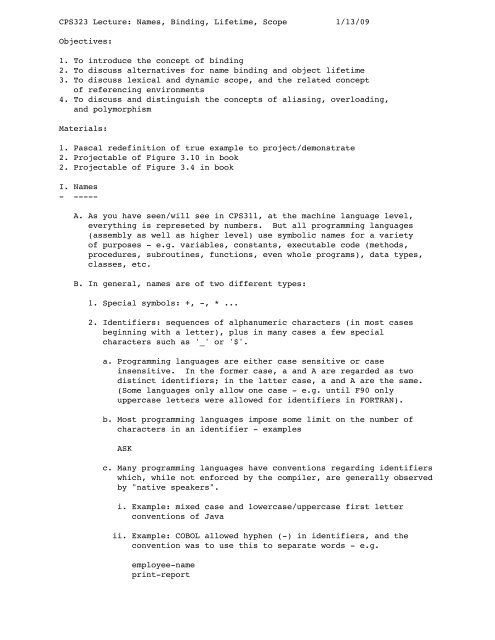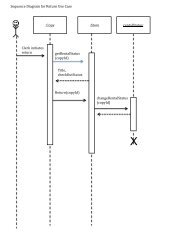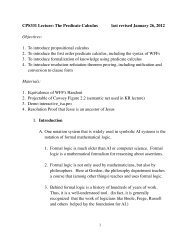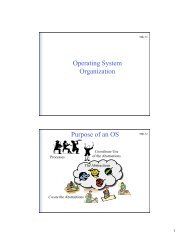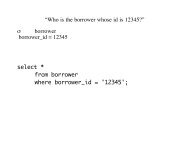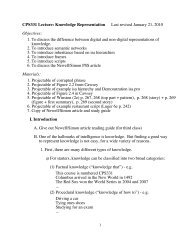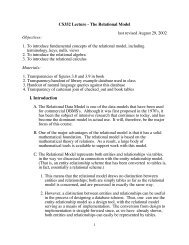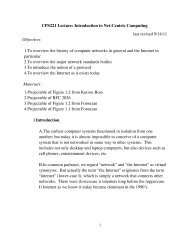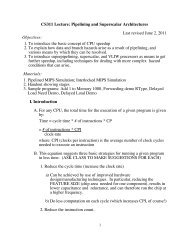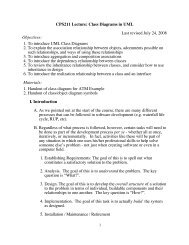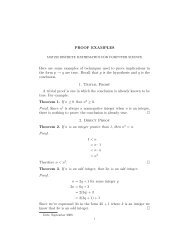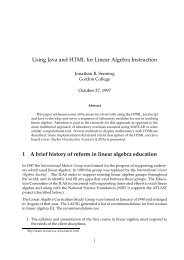Names, Binding, Lifetime, Scope
Names, Binding, Lifetime, Scope
Names, Binding, Lifetime, Scope
- No tags were found...
You also want an ePaper? Increase the reach of your titles
YUMPU automatically turns print PDFs into web optimized ePapers that Google loves.
3. Program write timeExample: many names are bound to specific meanings when a personwrites a program4. Compile time: the time when a single compilation unit is compiledExample: addresses in program code inside the unit5. Link time: the time when all the compilation units comprising asingle program are linked as the final step in buildingthe program. (A step you may not even be conscious of)Example: in most languages (though not Java), addresses of routinesin other compilations units6. Load time: the time when an executable program is loaded intomemory in order to execute itExample: Actual physical memory addresses of static variables andcode is often bound when the program is loaded.7. Run time: while the program is actually running.Example: Actual phyical memory addresses of variables created by"new" is bound when the "new" operation is executedD. Oftentimes, these are simplified into two possiblities.1. "Dynamic binding" is used to refer to anything bound while theprogram is running.2. "Static binding" is used to refer to anything bound prior to thattime - e.g. from Language Design time through Load Time.3. Examples: in a strongly-typed language such as Java, though thevalues of variables are bound dynamically, the types of variablesare bound statically. In contrast, there are dynamically-typedlanguages, where even the types of variables are bound at run time.III. <strong>Lifetime</strong>--- --------A. The word "lifetime" is used in two slightly different ways1. To refer to the lifetime of an _object_. (Here, we intend theterm in a more general sense than the way it is used in OO: we meanany entity that exists while a program is running, whether the programis explicitly OO or not.)2. The lifetime of the binding of a name to an object.3. In the simplest case, the two are equivalent - but that is not alwaysso.
a. An object can exist before the binding of a particular name to itExample (Java)void something(Object o) {// 2}....Object p = new Object()// 1....something(p);....// 3The object named by p exists at point 1, but the name o is notbound to it until point 2b. An object can exist after the binding of a particular name to ithas ceasedExample (the above)The object named by p continues to exist at point 3, even thoughthe binding of the name o to it ended when method something()completedc. A name can be bound to an object that does not yet existExample (Java)Object o;// 1....o = new Object(); // 2At point 1, the name o is bound to an object that does not comeinto existence until point 2d. A name can be bound to an object that has actually ceased to existExample (C++ - not possible in Java)Object o = new Object();...delete o; // 1...// 2At 2, the name o is bound to an object that has ceased to exist.(The technical name for this is a dangling reference).e. It is also possible for an object to exist without having any nameat all bound to it.
- Problems:ASK- Dangling references- Storage leaks- Reference-counting: each heap object maintains a count ofthe number of external pointers/references to it. When thiscount drops to zero, the space utilized by the object can bereallocated- Problems:ASK- tricky to keep this information current- circular structures break this - e.g.external reference --> [ A (2) ] --> [ B (1) ] --\______________________/if the external reference is dropped, A's reference countdrops to 1, so it looks like it is still alive, even thoughboth A and B should be subject to recycling!- Garbage collection: Periodically, all existing objects arechecked to see if there is any object with no outstandingreferences - in which case, it is garbage and can be recycled- This is the most elegant approach, but involves a fairamount of overhead- LISP, Java, and C#, among others, use this- A second issue that arises if objects have differing sizes(as they typically do), is Compaction of storage to avoidfragmentationIV. <strong>Scope</strong>-- -----A. Definition: the scope of a name binding is the portion of the text ofthe (source) program in which that binding is in effect - i.e. the namecan be used to refer to the corresponding object. Using a name outsidethe scope of a particular binding implies one of two things: either itis undefined, or it refers to a different binding.
Example:class Foo{private int n;void foo() {// 1}void bar() {int m,n;...// 2}...A reference to m at point 1 is undefinedA reference to n at point 1 refers to an instance variable of Foo; atpoint 2 it refers to a local variable of bar.B. There are two general approaches that programming languages have takento the scope issue.1. Dyanamic scope (early LISP, but a non-default option ion Common LISPand otherwise very rare). The scope of a binding is determined asthe program is running; a name always refers to the most recent bindingfor that name.2. Lexical (static) scope: The scope of a binding is determined by thestructure of the program's text. What a name refers to can always bedetermined at compile time.3. The book gives an example of the difference between these two, usinga (hypothetical) implementation of Pascal which allows a choice ofwhich sort of scope to use. (Pascal is actually always staticallyscoped)PROJECT, DISCUSS Figure 3.10 from the textIn both cases, there is a variable a in the main program that isinitialized to 2 in line 7, and written out in line 12- Dynamic scope: If the user enters a positive number, second is calledand it in turn calls first. In line 3, a refers to the most recentbinding for a at line 5 in second, so the value of the globalvariable a is unchanged, and 2 is written. If the user enters anegative or zero number, first is called directly, and the value ofa is changed to 1, so 1 is written- Static scope: line 3 always refers to the variable a declared at line1, so the program always writes 1
C. Since lexical scope is almost the universal convention in modernlanguages, we will discuss only this alternative. There are a number ofsubordinate issues.1. Nested scopes. Many programming languages allow scopes to benested inside each other.a. Example: The Java example defined earlierb. Example: Java actually allows classes to be defined inside classesor even inside methods, which permits multiple scopes to benested. An extreme (though legal) exampleclass Outer{int v1; // 1void methodO(){float v2; // 2class Middle{char v3; // 3void methodM(){boolean v4; // 4class Inner{double v5; // 5void methodI(){String v6; // 6}}}}}}The scope of the binding for v1 the whole programThe scope of the binding for v2 is methodO and all of classesMiddle and Inner, including their methodsThe scope of the binding for v3 is all of classes Middle andInner, including their methodsThe scope of the binding for v4 is methodM and all of classInner, including its methodThe scope of the binding for v5 is all of class Inner, includingits methodThe scope of the binding for v6 is just methodIc. Example: some programming languages - including Pascal and itsdescendants (e.g. Ada) - allow procedures to be nested insideprocedures. (C and its descendants do not allow this)Example: PROJECT Figure 3.4
d. With nested scopes, one can have the phenomon of _hole in scope_if a name is bound inside the scope of another binding for thesame nameExample: Suppose, in the above, that instead of binding v5 atpoint 5, we bound v1. Then the scope of the outerdeclaration of v1 (at point 1) would encompass all ofclasses Outer and Middle, while all references to v1 inclass Inner would refer to the inner binding at point 5.When hole in scope occurs, the meaning of a name is determined bythe nearest binding that contains the use of the name.e. How is nested scope handled in terms of stack frames? Refer againto the earlier Pascal examplePROJECT Figure 3.4 again- We say that P1 is a level 1 procedure; P2 and P4 are level 2;and P3 and F1 are level 3. (In general, the level of a routine is1 more than that of the routine that directly contains it, withthe outermost level being level 1).- Static scoping implies that a routine can call any routine at thesame or a lower-numbered level, or a routine numbered one levelhigher, but then only if that routine is contained within it - e.g.P1 can only call P1, P2 or P4.P4 can only call P1, P2, P4 or F1F1 can only call P1, P2, P4 or F1 [since there is nothing inside it]...P3 can only be called by P2F1 can only be called by P4- Static scoping also implies that a routine can only access itsown variables, and those declared in routines that contain it - e.g.P1 can only access variables declared in P1P2 can only access variables declared in P2 or P1P3 can only access variables declared in P3, P2 or P1P4 can only access variables declared in P4 or P1F1 can only access variables declared in F1, P4, or P1- Now suppose the following occurs:P1 is calledP1 calls P4P4 calls P2P2 calls P3P3 (recursively) calls P1
At this point, the stack looks like this-------------------| Frame for P1 |
2. Declaration ordera. When a declaration appears other than at the very beginning of ablock, does the scope of the declaration begin at the point ofthe declaration, or at the start of the block?Java exemplifies both of these at various points.- A field or method declared in a Java class can be used anywherein the class, even before its declaration.- A local variable declared in a method cannot be used before thepoint of its declarationExample: class Demo{public void method(){// Point 1}int y;}private int x;The instance variable x can be used at Point 1, but not yb. There are good reasons for both approaches- In favor of beginning scope at point of declaration: avoidsneed to read program twice.- In favor of beginning scope at start of block: required formutually recursion.Example: Javaclass Demo{public void method1(){...method2();...}}public void method2(){...method1();...}Languages that begin scope at point of declaration need toresort to other strategies to support mutual recursion: somesort of provision for "forward" or incomplete declarations.
Example: C/C++:void method2(); // Incomplete declarationvoid method1();{...method2();...}void method2() // Definition completes the abov{...method1();...}c. A second question: if the scope of a name begins at the pointof its declaration, and there is another declaration for the samename in an outer scope, what happens if the name is used beforeits declaration?- The outer declaration is used- The use is illegalExample: Add private int y; as an instance variable in the above;now if x is used at point 1, does it refer to thisdeclaration or is it illegal? (You will explore onhomework)3. The notion of elaboration at scope entrya. We normally think of a declaration as simply giving meaning to aname, but sometimes a declaration also involves some computation.Example: Robot karel = new Robot(...);b. This computation is typically done whenever its scope is entered.Example: in Java, if an instance field has an initializer, theinitializer is executed whenever an instance of theclass is created.c. The phrase "elaboration of a declaration" is used by some languages(e.g. Ada) to refer to this. In some cases, a fair amount ofcomputation may need to occur, depending on what is being declared.D. Name spaces and qualified names1. If a program is large, there is significant danger that the same namewill be used for two different things - perhaps as a result of multipleprogrammers independently working on different parts of the program.2. To prevent problems like this, many languages incorporate some sort ofmechanism whereby a name is qualfied in some way.
Example: in Java, the name of a class is qualified by the name ofthe package in which it occurs - e.g. java.io.Filein Java, again, the name of a method or field is qualified bythe name of a class or an object of that class - e.g.Math.PI or System.out.println.Example: in C++, a name may be qualified by a namespace, separated fromthe name by :: - e.g. std::cout3. Since always specifying qualifiers can generate a lot of typing,languages that have name spaces typically incorporate a facility forusing a namespace or importing one or more names from a namespaceExample: in Java: import java.io.File; allows File to be used in theimporting file without being qualified by java.io.V. Some Miscellaneous Issues- ---- ------------- ------A. Aliasingin Java: import static java.lang.Math.* allows _all_ staticnames defined in class Math to be used without being qualifiedby Math. - e.g. after the above, one could use PI instead ofMath.PI.in C++: using namespace std allows all names defined innamespace std to be used without qualification - e.g. afterthe above, one could use cout instead of std::coutA similar facility exists in Ada.Two names are said to be aliases if they are names for the same thing.1. Aliases can be created by assignment of pointers/referencesExample: Java: Robot karel = ...Robot foo = karel;foo and karel are aliases for the same Robot object2. Aliases can be created by passing reference parametersExample: C++void something(int a [], int & b){// 1...}int x [100];int y;something(x, y);After the call to something(x, y), at point 1 x and a are aliasesfor the same array
3. In general, aliases make understanding a program (or proving itscorrectness) more challenging because changing an object throughone alias affects its meaning when accessed through another aliasas well.B. OverloadingA name is said to be overloaded if, in some scope, it has two or moremeanings, with the actual meaning being determined by how it is used.Example: C++void something(char x)...void something(double x)...// 1At point 1, something can refer to one or the other of the twomethods, depending on its parameter.C. Overloading permits polymorphism.1. Compile-time (static) polymorphism: the meaning of a name isdetermined at compile-time from the declared types of what it usesExample: in the above C++ example, something(3.14) will refer tothe second definition of something; this determination is madeat compile time2. Run-time (dynamic) polymorphism: the meaning of a name isdetermined when the program is running from the actual types of whatit uses.3. Example: Java has both types in different contexts:a. When a name is overloaded in a single class, static polymorphismis used to determine which declaration is meant.b. When a name is overridden in a subclass, dynamic polymorphism isused to determine which version to use.4. In contrast, C++ uses static polymorphism in both cases by default,though dynamic polymorphism can be used for overrides if a method isdeclared virtual.D. GenericsSome languages permit generic (template) declarations, in which thedefinition of a name is parameterized.Example: Java genericsExample: C++ templates


